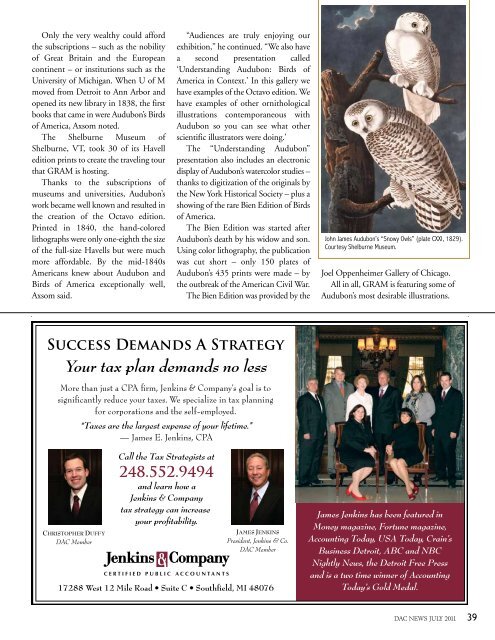Detroit and the Civil War Detroit and the Civil War Detroit and the ...
Detroit and the Civil War Detroit and the Civil War Detroit and the ...
Detroit and the Civil War Detroit and the Civil War Detroit and the ...
You also want an ePaper? Increase the reach of your titles
YUMPU automatically turns print PDFs into web optimized ePapers that Google loves.
C<br />
M<br />
Y<br />
CM<br />
MY<br />
CY<br />
CMY<br />
K<br />
Only <strong>the</strong> very wealthy could afford<br />
<strong>the</strong> subscriptions – such as <strong>the</strong> nobility<br />
of Great Britain <strong>and</strong> <strong>the</strong> European<br />
continent – or institutions such as <strong>the</strong><br />
University of Michigan. When U of M<br />
moved from <strong>Detroit</strong> to Ann Arbor <strong>and</strong><br />
opened its new library in 1838, <strong>the</strong> first<br />
books that came in were Audubon’s Birds<br />
of America, Axsom noted.<br />
The Shelburne Museum of<br />
Shelburne, VT, took 30 of its Havell<br />
edition prints to create <strong>the</strong> traveling tour<br />
that GRAM is hosting.<br />
Thanks to <strong>the</strong> subscriptions of<br />
museums <strong>and</strong> universities, Audubon’s<br />
work became well known <strong>and</strong> resulted in<br />
<strong>the</strong> creation of <strong>the</strong> Octavo edition.<br />
Printed in 1840, <strong>the</strong> h<strong>and</strong>-colored<br />
lithographs were only one-eighth <strong>the</strong> size<br />
of <strong>the</strong> full-size Havells but were much<br />
more affordable. By <strong>the</strong> mid-1840s<br />
Americans knew about Audubon <strong>and</strong><br />
Birds of America exceptionally well,<br />
Axsom said.<br />
JAC101710DACad.pdf 1 10/20/10 4:54 PM<br />
“Audiences are truly enjoying our<br />
exhibition,” he continued. “We also have<br />
a second presentation called<br />
‘Underst<strong>and</strong>ing Audubon: Birds of<br />
America in Context.’ In this gallery we<br />
have examples of <strong>the</strong> Octavo edition. We<br />
have examples of o<strong>the</strong>r ornithological<br />
illustrations contemporaneous with<br />
Audubon so you can see what o<strong>the</strong>r<br />
scientific illustrators were doing.’<br />
The “Underst<strong>and</strong>ing Audubon”<br />
presentation also includes an electronic<br />
display of Audubon’s watercolor studies –<br />
thanks to digitization of <strong>the</strong> originals by<br />
<strong>the</strong> New York Historical Society – plus a<br />
showing of <strong>the</strong> rare Bien Edition of Birds<br />
of America.<br />
The Bien Edition was started after<br />
Audubon’s death by his widow <strong>and</strong> son.<br />
Using color lithography, <strong>the</strong> publication<br />
was cut short – only 150 plates of<br />
Audubon’s 435 prints were made – by<br />
<strong>the</strong> outbreak of <strong>the</strong> American <strong>Civil</strong> <strong>War</strong>.<br />
The Bien Edition was provided by <strong>the</strong><br />
John James Audubon’s “Snowy Owls” (plate CXXI, 1829).<br />
Courtesy Shelburne Museum.<br />
Joel Oppenheimer Gallery of Chicago.<br />
All in all, GRAM is featuring some of<br />
Audubon’s most desirable illustrations.<br />
DAC NEWS JULY 2011<br />
39








